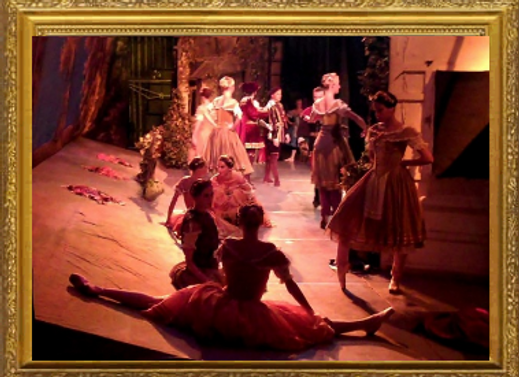

Giselle photo taken backstage Mariinsky Theatre St. Petersburg. Russia by Roy Webb
GISELLE Giselle is arguably the most mystical ballet in the repertoire today. Let’s start with the fact that its libretto is based on a fantastical story about a love that overcomes the barriers between two worlds. It is a story in which the young heroine, dying from a broken heart, mysteriously hears the call of ghosts tempting her to join their round dance, and having become one of them she saves the lover who betrayed her. In the era of romanticism, the apogee of searches in ballet came with Giselle which was created in 1841, and tales of other worlds were well familiar to audiences.
Giselle, too, was an ideal embodiment of a romantic dual world where the living energy in scenes from real life in Act I is contrasted with the bewitching incorporeality of the dance of the wilis in Act II. It was not without the influence of this popular production that that the subsequent ballet repertoire was enriched with different shadows, nymphs and other inhabitants of visions. Besides the plot, the history of the ballet is also full of enigmatic transformations. These transformations may not always be mystical, often they are easily explicable in terms of logic, but they are reminiscent of a detective investigation as an attempt to establish those who created the ballet and their share of the input into creating the masterpiece Giselle, and they have ensured the fame of this incredibly mysterious ballet.
Full length Ballet in Two Acts Music: Adolphe Adam. Click below and view full screen.
Synopsis Act I Count Albrecht, in love with the peasant girl Giselle, keeps his noble status a secret from her. Giselle’s other admirer Hans, a woodsman, tries to warn her that Albrecht is not who he claims to be, but Giselle doesn’t want to hear him. Left alone, Hans enters the hunter’s cottage and removes Albrecht’s sword with bears his noble coat of arms. The sounds of a horn announce the arrival of a hunting party, amongst whom the Count’s betrothed – Bathilde and her father. They stop to seek rest in the village. The Count’s fiancée, charmed by Giselle’s innocence and beauty, gives the girl an expensive necklace. The hunting party retires and the peasants begin a celebration of their own to mark the harvest. At the height of the festivities Hans appears. He accuses Albrecht of lying and shows the Count’s sword as proof. Giselle refuses to believe it. Then Hans blows the hunting horn and before the embarrassed Count his fiancée appears. Giselle is in despair. She loses her reason and dies. Act II It is midnight. Hans has come to Giselle’s grave. The Wilis appear – the ghosts of brides who died before their weddings – and frighten him.
They emerge from their graves with a passion to dance the way they could not when still alive and anyone who happens to be in the graveyard at the time must dance till they drop dead. Myrtha, the Queen of the Wilis, summons Giselle’s soul from her tomb and initiates her into their order. Count Albrecht comes to his beloved’s grave. His grief and despair touch Giselle. She forgives Albrecht. The Wilis force Hans to dance until he is exhausted and, spinning round, throw him into the lake. The same fate awaits Albrecht. Myrtha forces him to dance. Giselle begs Myrtha to set Albrecht free but Myrtha is unmoved. Dawn breaks. With the rise of the sun the Wilis lose their power. Albrecht is saved. Giselle bids farewell to her beloved – this time forever...
GISELLE
Full length Ballet in Two Acts
Music: Adolphe Adam
Libretto: Jules-Henri Vernoy de Saint-Georges and Théophile Gautier
Choreography: Jean Coralli, Jules Perrot, Marius Petipa
Stage version and editorial by Elena Radchenko
Sets: Lev Solodovnikov,
Costumes: Elena Radchenko & Sergey Radchenko
Lighting : Marina Borodina
History
Giselle : is a ballet in two acts with a libretto by Jules-Henri Vernoy de Saint-Georges and Théophile Gautier, music by Adolphe Adam, and choreography by Jean Coralli and Jules Perrot. The librettist took his inspiration from a poem by Heinrich Heine. The ballet tells the story of a peasant girl named Giselle whose ghost, after her premature death, protects her lover from the vengeance of a group of evil female spirits called Wilis . Giselle was first presented in Paris, France, on 28 June 1841. The choreography in modern productions generally derives from the revivals of Marius Petipa for the Imperial Russian Ballet (1884, 1899, 1903). Giselle was first seen in Moscow in 1843, just two years after its creation in Paris, and a year after it was staged in St. Petersburg. The ballet’s history in Russia since that time has shown a continuous sequence of performances, with Jules Perrot — one of the great originators of the choreography — providing a basic text which has been illuminated by the care and genius of generations of ballerinas and producers. When Giselle was forgotten everywhere else in Europe — it was dropped from the Paris Opera repertory in 1868 — Russian dancers and ballet-masters preserved and honored it.
PROGRAM NOTES
Act I: A Rhineland Village
Giselle, a peasant girl, has fallen in love with Count Albrécht, who has led her to believe that he is a villager named Loys. Her superstitious mother, Berthe, hoping that Giselle will marry the forester Hilarion, warns her against Loys, to whom she has taken an instinctive dislike.
In order to discourage Giselle’s love for ‘Loys’, Berthe further recounts the legend of the Wilis — ghosts of young girls who have been jilted and die before their wedding day: to avenge themselves, they dance to death any man who crosses their paths between midnight and dawn. But Giselle disregards her mother and joins, with her beloved, in the celebrations that mark the end of the grape harvest, when she is crowned Queen of the Vintage.
Wilfred, Albrécht’s squire, secretly warns him that a hunting party is approaching, led by the Duke of Courland and the Countes Bathilde (Albrécht’s future bride), who are staying at Albrécht’s castle for the betrothal ceremony. Albrécht hides, but Hilarion has witnessed this meeting and decides to break in to ‘Loy’s’ cottage to discover the secret of his identity. The hunting party arrives. Giselle dances for the nobles and when she tells Bathilde that she too is engaged, the Countess gives her a necklace. Bathilde, tired from hunting, asks to rest in Berthe’s cottage, but the Duke decides to continue the hunt and orders a hunting horn to be left by the cottage door so that he and the rest of the party may be recalled when Berthe is ready to rejoin them. Hilarion now reappears from «Loys’s cottage. He has found Albrécht’s sword and when he compares it with the hunting horn, he sees that they bear the same crest; this gives him the evidence for which he has been looking. Not realizing that the hunt is still nearby, Albrécht returns. Hilarion interrupts the dancing and reveals the truth about ‘Loys’. He sounds the horn, the hunting party returns and Bathilde, coming out of the cottage, claims Albrécht as her fiancé. The shock is too much for Giselle and she loses her reason. In her madness she relives her love for ‘Loys’ and, seizing his sword, she kills herself.
-Intermission-
Act II: Giselle’s Grave in the Forest
Hilarion keeps vigil by Giselle’s grave, which lies deep in the forest in unconsecrated ground. It is midnight, the time when the Wilis materialize. Hilarion flees in terror when confronted by these apparitions. Myrthe, their queen, now arrives from the marshes and summons her Wilis. She draws Giselle from her grave to be initiated into their rites. The Wilis disperse as Albrécht approaches, searching for Giselle’s grave. He lays flowers at the cross and when Giselle’s spirit appears to him, he follows it into the forest.
Hilarion, pursued by the Wilis, returns and is forced into an endless dance. Exhausted, he is driven into the lake, where he drowns. The Wilis now seek out Albrécht and when Myrthe commands him to dance, Giselle urges him to the safety of the cross, but he is powerless when Myrthe orders Giselle to entice him away by dancing with him. Giselle tries to sustain him, but as the night wears on he becomes weaker and weaker. Just as he is about to die, dawn breaks. Daylight destroys the Wilis’ power and the ghostly dancers fade away; Giselle, whose love has transcended death, returns to her grave, her spirits freed from the power of the Wilis, leaving Albrécht sorrowing and alone.

